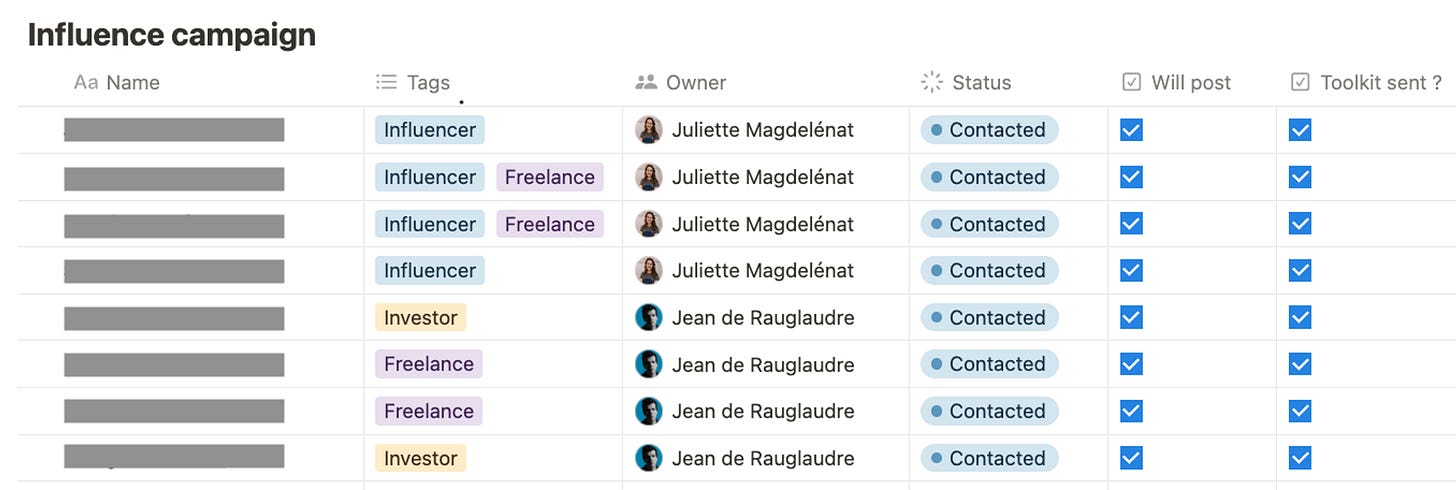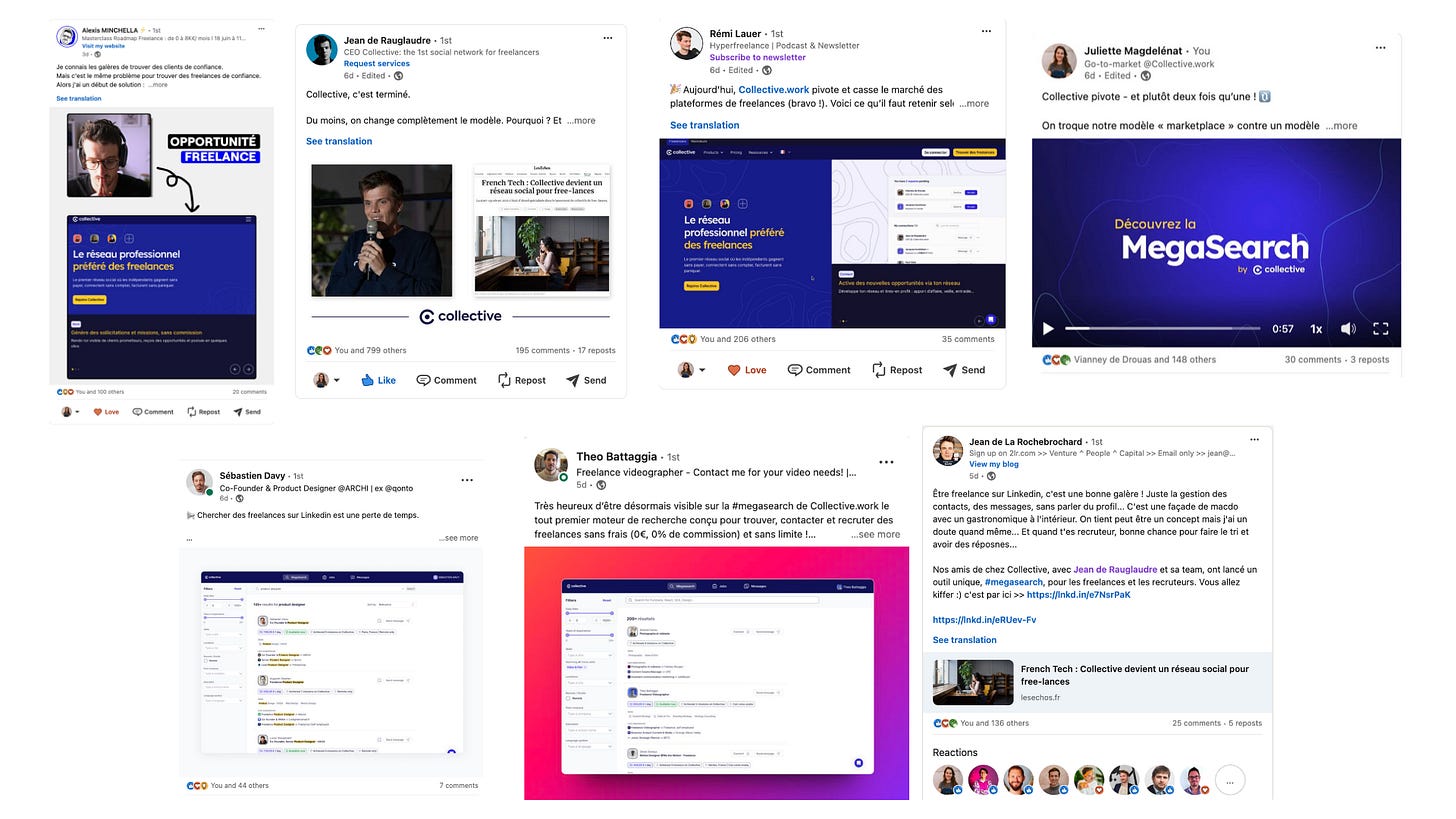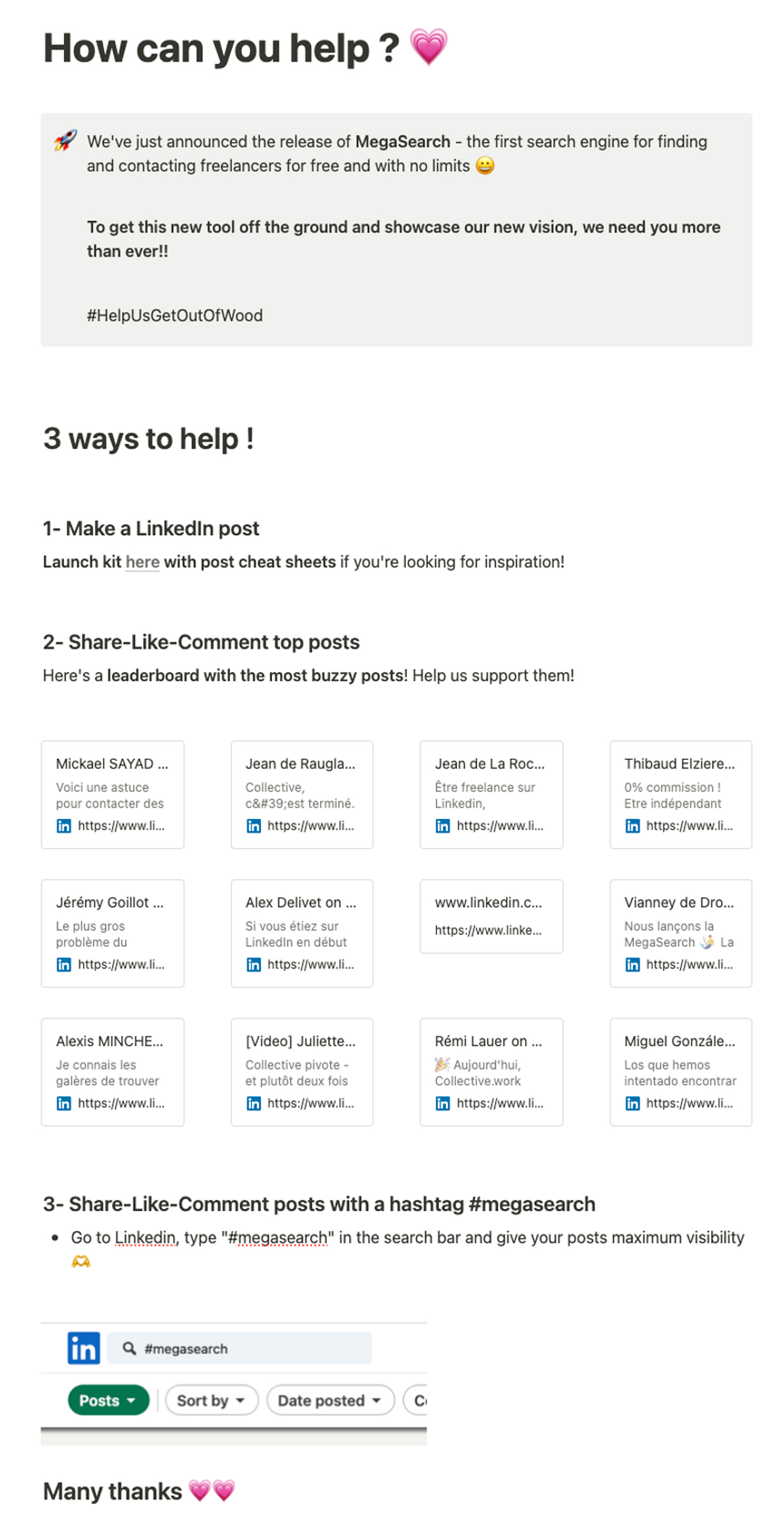How I Successfully Launched My B2B Product on Linkedin.
Game-changing tips by Juliette Magdelénat (Collective).
Two weeks ago, my Linkedin feed got massively invaded.
Collective a Paris-based freelancing platform was announcing their pivot as the “First Professional Social media platform for freelancers”.
Tech influencers, podcasters, people from my personal network… Everyone was buzzing about it.
Turns out they reached +1 Million people organically while having 90% of LinkedIn posts written by users.
I was so amazed by the results that I asked Juliette Magdelénat, who’s in charge of the Go-To-Market at Collective, to share her secrets in The Product Courier.
In this edition, you’ll learn:
✅ Why having a great story makes a difference.
✅ How to turn your users into ambassadors.
✅ Her process to involve and align teams.
✅ A “cheat” to engage people, even if they don’t feel comfortable posting on Linkedin.
Enjoy these practical tips! ⬇️
Most B2B launches on LinkedIn are boring.
They usually look like this:
A Linkedin post on the company page
A few re-shares from team members,
… and that’s pretty much it.
But let's also be honest. Standing out on LinkedIn is incredibly challenging:
It’s an overly crowded space.
Most content is noise.
Users attention span is extremely limited.
LinkedIn organic post reach has been dramatically reduced over the last few weeks.
Although it's not easy to launch successfully, it's not impossible.
Last week, I launched my company's most ambitious feature, and it’s been a huge success. 📊
130 Linkedin posts were published (80% users, 10% investors, 10% employees).
+1 Million of people reached.
150x increase on our web traffic. (day on day)
40x increase on our sign-ups, (day on day)
At what cost? 💰
0€ on Linkedin ads
0€ for Press
0€ for Influencers
2.000 € for a production video.
Here are 5 keys that helped us succeed.
#1. Start with a great story.
Collective was founded in 2021. Initially, we were known as a platform designed to help freelancers work together in "collectives" and connect with potential clients (recruiters, companies, and so on).
After a few years, we realized our business was leaning towards a traditional agency, not focusing enough on the product and tech side. This approach was significantly limiting our potential. Our scaling capacity was constrained by our sales force - like any other agency.
More importantly, we felt we were missing the essential element: our target's main need for networking.
Freelancers have a high demand for mutual assistance, mentorship, peer learning, support, and recommendations. We realized that collectives were just one use-case, but collaboration was a much broader topic.
We knew we had to aim for something bigger and more ambitious - a product that would better serve our users' needs.
So we decided to pivot the company and become the first professional social network for freelancers.
This pivot would be embodied by the launch of a core new feature: the MegaSearch.
The MegaSearch addresses the needs of our two main personas:
It helps freelancers become visible to recruiters, get contacted for free (0% fee), develop and engage their network, and professionalize through the use of collaborative tools (team quotes, joint-invoicing, payment, etc.).
It helps recruiters source, contact and recruit our 20,000 freelancers, for free.
We were convinced that positioning Collective as the professional social network for freelancers would be a winning bet because it's:
Easy to identify for both freelancers and recruiters.
Ambitious enough to carry our mission.
Underserved by our competitors.
With our story in place, we needed to ensure everyone was on board.
This brings us to our next crucial step: aligning teams.

#2. Involve all your teams (and make sure they’re aligned!)
Having everyone involved and properly synchronized is a major factor of success for any product launch.
Here are three strategies we used:
Help people get quickly familiar with the positioning: Since this wording will be used across various platforms (posts, media, video, website, etc.), it is essential to find the right angle and ensure everyone feels comfortable with the story.
Set a launch date and stick to it: Announcing a launch date creates a sense of urgency and aligns all teams (Tech, Product, Business) towards a common goal. We gave ourselves a month to prepare, iterate on the product, and align everyone before the launch.
Establish a clear launch process: Define a step-by-step process including timelines, roles, and responsibilities to ensure everyone knows their tasks and deadlines. We conducted daily updates to track progress. Here's a glimpse of our GTM planning (excluding the equally busy Tech schedule).
#3. Turn your users into ambassadors.
Peer-to-peer referral is the best vector for credibility and brand awareness (and it's free).
Your best current users often closely match your Ideal Customer Profile (ICP). These users tend to know and interact with people similar to themselves. So, if you want to attract more ideal users to your platform, your most effective strategy is to turn your existing top users into ambassadors for your product.
The best way to do this is 1) to tease them and 2) to make it easy for them to help you!
Step 1.
Create a trackable contact list.
Here’s been our process:
We carefully compiled a list of our most active users and contacted each of them personally, ten days before the launch.
To create this list, I extracted data from Metabase based on several criteria (number of missions completed with us, ranking on the MegaSearch, etc.).
For outreach, we used a simple and cost-effective method: saving a Gmail snippet with the message template. This allowed us to send messages in sequence for free, saving a lot of time.

Our objective was to involve a broad range of supporters who genuinely value our initiative, so we expanded our outreach to:
Investors in the tech ecosystem
Influencers who resonates with our personas
Former employees
💡 Special Tip: once you’ve made your list, stay organized to track who you’ve contacted, who accepted, and who you’ve sent your kit to, it will help you later (and save you from a few headaches).
Step 2.
Create a Linkedin launch kit that simplifies posting for everyone.
With our list of potential ambassadors in hand, our next challenge was to create compelling marketing materials that would inspire them to share enthusiastically on launch day.
Given that video content is highly engaging on LinkedIn, we prioritized it. If you invest in an expensive video (around €2K), I would recommend making sure to reuse it over several months. Focus on presenting the product idea broadly without delving into too many interface details, as these can change rapidly.
Once the video was ready, I began preparing the launch kit—an essential step! This kit was designed to make posting as effortless and effective as possible for our supporters.
It included:
Pre-written posts (a must have)
Our feature video
Eye-catching images
Strategic posting tips
Clear guidelines for consistent messaging
By providing these resources, we made it easy for our ambassadors to create impactful, on-brand posts with minimal effort on their part.
Remember: The easier you make it for people to support you, the more likely they are to do so enthusiastically.
I really advise you to go through that step. It’s game changer!
Here are a few screenshots from our Launch Kit.
Here’s our Launch kit: Launch kit - MegaSearch
Managing timing will be key to your success.
Here are my recommendations on this matter:
10 days before launch: Reach out to potential launch supporters and request their participation by posting on LinkedIn.
5 days before launch: Send the Launch Kit to those who have agreed to help.
1 day before launch: Send a calendar invitation to remind supporters to post on launch day. The optimal time to post on LinkedIn is 9:30 AM, so make sure to specify this in both the invitation and the Launch Kit.
#4. Amplify your reach on D-Day.
LinkedIn is a social network: actively engaging with posts from your users is crucial to increase your reach.
Here are a few tips to make the most of your launch day:
Massively support all posts:
Actively engage with the posts by liking, commenting, and sharing to boost visibility.
Encourage everyone in your company to share and endorse all the content.
Create a Slack channel internally to share all the posts and help all employees support them easily
Stay Organized:
Update your “ambassadors post tracker”every hour to see who has posted and who you can kindly send a reminder to.
Our cheat strategy to engage non-posters.
Some people don’t feel confortable posting on Linkedin - and that’s ok.
We sent a “How-can-you-help kit”. This provided a more discreet alternative, asking them to support the top 10 posts of the day (leaderboard) and those with the hashtag #megasearch.
This significantly amplified the visibility of our posts and helped maintain momentum.
Here’s a screenshot from our “How-you-can-help kit”.
# 5. Four last tips to successfully launch on Linkedin.
They may seem trivial, but they are nonetheless important.
Ensure Product lovability before launching: Your product doesn't need to be perfect, but it must be lovable. This encourages users to share it willingly during launch.
Engage users early: Start a soft launch at least two months before the main event. This will allow you to gather feedback, make improvements, and involve your users in building your Product. (Hence making it more lovable).
Prepare your website before the launch: Ensure your website is fully functional and optimized before the launch. Traffic will soar so you want to convey the right message. On our end, we started a bit late, so the night before the launch at 11 PM we were still making changes on Webflow. If I had to do it again, I would plan this stream better.
Stay active post-launch: Don’t lose the momentum after your launch day! Posts will keep coming in so continue to engage with your audience and treat everyone equally. Try to ride the wave for as long as possible.
What I’ve personally learned from this launch.
Preparation pays off: The high volume of posts from our users resulted from starting the operation well in advance and managing it meticulously.
Pre-launch street-cred is important: Initiate your soft launch early before the official launch. It's easier to make an impact when your tool has already sparked interest.
Lovable products foster support: When a product is designed to be lovable and users are involved early in its development, they are more inclined to offer genuine support. ⚠️ People are helpful, but also lazy. Most will help you, but only if you make it easy for them.
Impact goes beyond business: A successful launch can get your name noticed beyond potential users (e.g., VC, media, partners). For instance, it was after our launch that I met Lucas from this newsletter, who reached out to write an article.
And as a finale thought, I’d say this:
Going the extra mile is incredibly rewarding.
Most product launches are boring. Putting in the effort to make them successful is 100% worth it. You’ll see your KPIs soar, LinkedIn posts cascade, and visibility increase. On the human side, you’ll immediately feel a boost in motivation, with everyone proud of this collective success (tech, product, and business teams)!
Resources 📚:
Our Launch kit - MegaSearch to encourage users to support us.
How-can-you-help kit to engage users who don’t feel comfortable posting on Linkedin.
Best of luck with your launches!
Btw, I'm Juliette, an optimistic worker passionate about product GTM strategies 😊
Feel free to contact me on LinkedIn - I’m always happy to help start-ups in their launches, and to share my best practices!












Thank you for hosting me ! Happy to discuss it more in details or to help anyone with their launch !